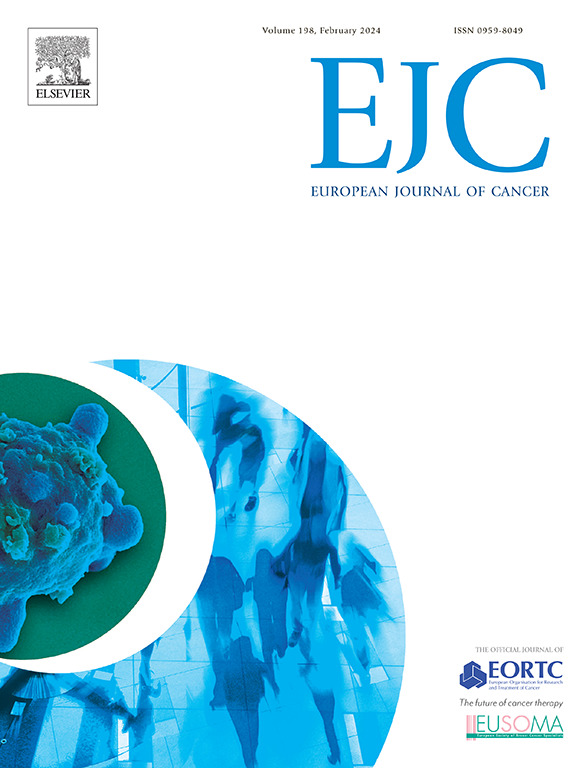Artificial intelligence-based virtual staining platform for identifying tumor-associated macrophages from hematoxylin and eosin-stained images
IF 7.6
1区 医学
Q1 ONCOLOGY
引用次数: 0
Abstract
Background
Virtual staining is an artificial intelligence-based approach that transforms pathology images between stain types, such as hematoxylin and eosin (H&E) to immunohistochemistry (IHC), providing a tissue-preserving and efficient alternative to traditional IHC staining. However, existing methods for translating H&E to virtual IHC often fail to generate images of sufficient quality for accurately delineating cell nuclei and IHC+ regions. To address these limitations, we introduce VISTA, an artificial intelligence-based virtual staining platform designed to translate H&E into virtual IHC.
Methods
We applied VISTA to identify M2-subtype tumor-associated macrophages (M2-TAMs) in H&E images from 968 patients with HPV+ oropharyngeal squamous cell carcinoma across six institutional cohorts. M2-TAMs are a critical component of the tumor microenvironment, and their increased presence has been linked to poor survival. Co-registered H&E and CD163 + IHC tissue microarrays were used to train (D1, N = 102) and test (D2, N = 50) the VISTA platform. M2-TAM density, defined as the ratio of M2-TAMs to total nuclei, was derived from VISTA-generated CD163 + IHC images and evaluated for prognostic significance in additional training (D3, N = 360) and testing (D4, N = 456) cohorts using biopsy or resection H&E whole slide images.
Results
High M2-TAM density was associated with worse overall survival in D4 (p = 0.0152, Hazard Ratio=1.63 [1.1–2.42]). VISTA outperformed existing methods, generating higher-quality virtual CD163 + IHC images in D2, with a Structural Similarity Index of 0.72, a Peak Signal-to-Noise Ratio of 21.5, and a Fréchet Inception Distance of 41.4. Additionally, VISTA demonstrated superior performance in segmenting M2-TAMs in D2 (Dice=0.74).
Conclusion
These findings establish VISTA as a computational platform for generating virtual IHC and facilitating the discovery of novel biomarkers from H&E images.
基于人工智能的虚拟染色平台,用于从苏木精和伊红染色图像中识别肿瘤相关巨噬细胞
背景虚拟染色是一种基于人工智能的方法,它能将苏木精和伊红(H&E)等染色类型之间的病理图像转换为免疫组化(IHC)图像,为传统的 IHC 染色提供了一种既能保护组织又高效的替代方法。然而,现有的将 H&E 转化为虚拟 IHC 的方法往往无法生成足够高质量的图像,无法准确划分细胞核和 IHC+ 区域。为了解决这些局限性,我们引入了 VISTA,这是一种基于人工智能的虚拟染色平台,旨在将 H&E 转化为虚拟 IHC。方法我们应用 VISTA 在 H&E 图像中识别了 M2 亚型肿瘤相关巨噬细胞(M2-TAMs),这些巨噬细胞来自六个机构队列中的 968 名 HPV+ 口咽鳞癌患者。M2-TAMs是肿瘤微环境的重要组成部分,它们的增加与生存率低下有关。共登记的 H&E 和 CD163 + IHC 组织芯片用于训练(D1,N = 102)和测试(D2,N = 50)VISTA 平台。M2-TAM密度定义为M2-TAMs与总细胞核的比率,由VISTA生成的CD163 + IHC图像得出,并使用活检或切除的H&E全切片图像在额外的训练组(D3,N = 360)和测试组(D4,N = 456)中评估其预后意义。结果在D4中,高M2-TAM密度与较差的总生存率相关(p = 0.0152,危险比=1.63 [1.1-2.42])。VISTA 优于现有方法,在 D2 中生成了更高质量的虚拟 CD163 + IHC 图像,其结构相似性指数为 0.72,峰值信噪比为 21.5,弗雷谢特起始距离为 41.4。此外,VISTA 在分割 D2 中的 M2-TAMs 方面表现出色(Dice=0.74)。
本文章由计算机程序翻译,如有差异,请以英文原文为准。
求助全文
约1分钟内获得全文
求助全文
来源期刊

European Journal of Cancer
医学-肿瘤学
CiteScore
11.50
自引率
4.80%
发文量
953
审稿时长
23 days
期刊介绍:
The European Journal of Cancer (EJC) serves as a comprehensive platform integrating preclinical, digital, translational, and clinical research across the spectrum of cancer. From epidemiology, carcinogenesis, and biology to groundbreaking innovations in cancer treatment and patient care, the journal covers a wide array of topics. We publish original research, reviews, previews, editorial comments, and correspondence, fostering dialogue and advancement in the fight against cancer. Join us in our mission to drive progress and improve outcomes in cancer research and patient care.
 求助内容:
求助内容: 应助结果提醒方式:
应助结果提醒方式:


